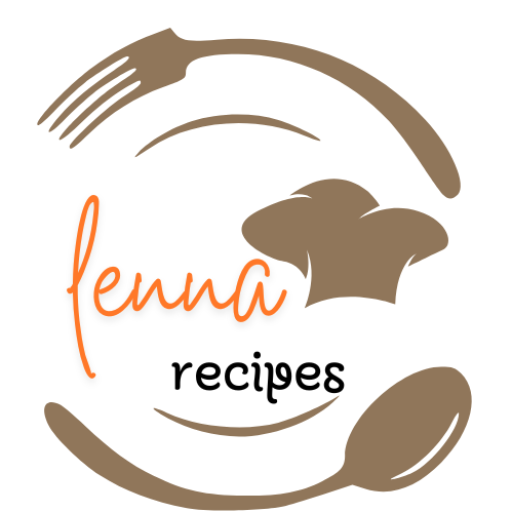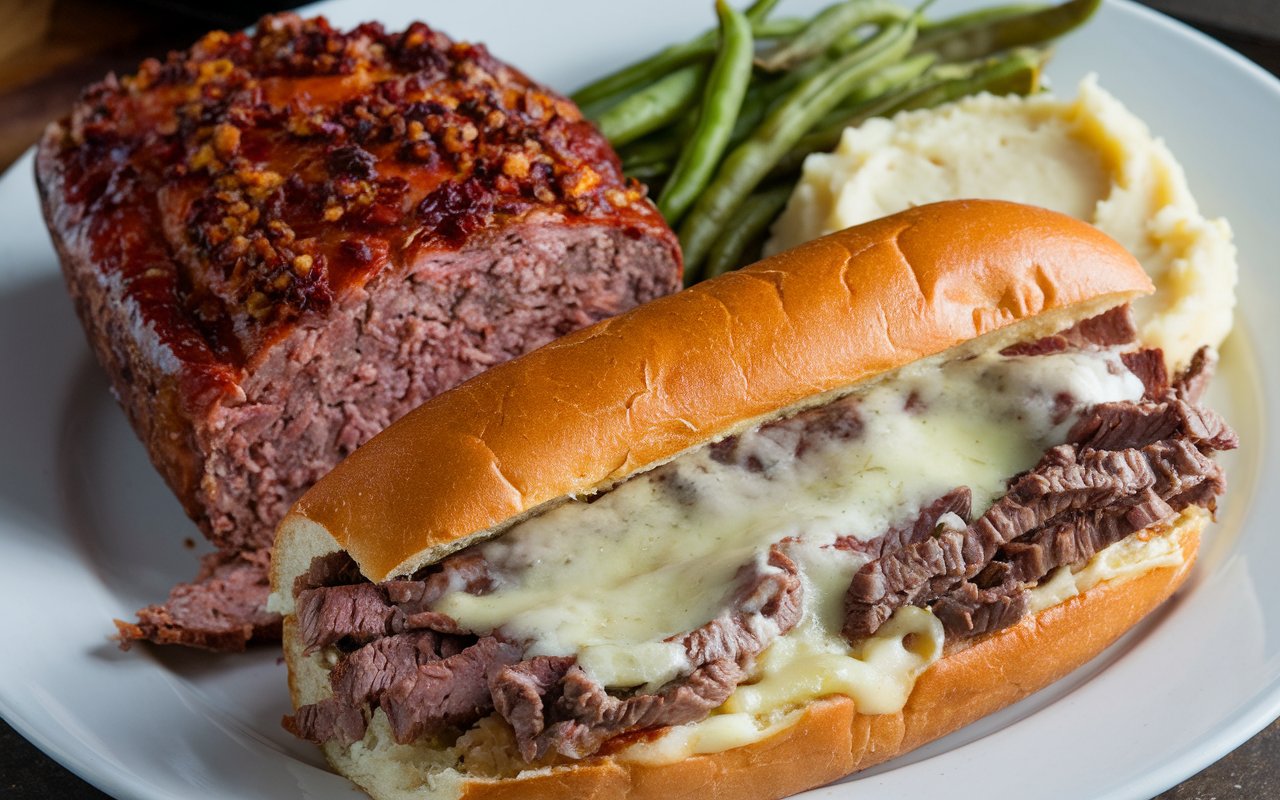Few dishes embody comfort food quite like cheesesteak and meatloaf. http://cheesesteak and meatloaBoth have carved a niche in culinary culture, with cheesesteak’s sizzling flavors enticing fast-food lovers and meatloaf’s homestyle appeal offering nostalgic comfort. These classics transcend mere meals, symbolizing hearty indulgence and family traditions.
Cheesesteak hails from the bustling streets of Philadelphia, while meatloaf boasts a history that spans centuries and continents. Both dishes are known for their versatility, with numerous variations tailored to local tastes and global influences. This guide dives into the origins, cultural significance, and preparation methods of these iconic dishes.
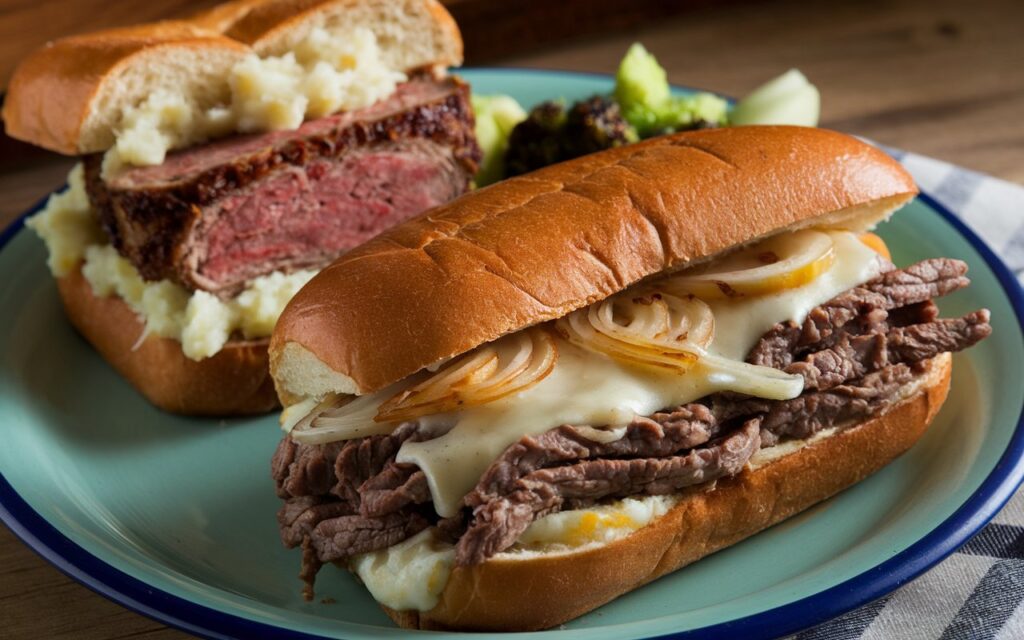
2. The History of Cheesesteak: Birthplace and Evolution
The cheesesteak was born in Philadelphia in the early 1930s, thanks to the entrepreneurial spirit of Pat and Harry Olivieri. What began as a simple sandwich—thinly sliced beef on a roll—gained popularity when cheese was introduced, creating the signature flavor combination we know today.
From its humble beginnings, the cheesesteak has evolved into a national treasure. Regional adaptations and toppings, such as fried onions and peppers, have added unique twists. Yet, the essence of the dish—a harmonious blend of beef, cheese, and bread—remains timeless.
3. Meatloaf Through Time: From Ancient Origins to Modern-Day Classic
Meatloaf’s roots trace back to ancient Rome, where recipes for minced meat mixed with spices and bread crumbs were documented. Over centuries, variations emerged across Europe, with each region incorporating local flavors.
In America, meatloaf gained popularity during the Great Depression, offering an economical way to stretch meat supplies. Today, it is celebrated as a quintessential comfort food, with recipes ranging from traditional ketchup-glazed loaves to gourmet creations featuring bacon or exotic spices.
4. Regional Variations of Cheesesteak: A Taste of Philadelphia
While the Philadelphia cheesesteak remains the gold standard, regional adaptations abound. From the addition of peppers and mushrooms in New York to spicy jalapeños in Texas, every locale puts its spin on this classic.
Key differences include:
- Bread: Authentic cheesesteaks are served on Amoroso rolls, but alternatives like hoagie buns are common elsewhere.
- Cheese choices: Provolone and Cheese Whiz dominate in Philadelphia, while mozzarella and pepper jack are popular in other regions.
- Toppings: Variations range from plain onions to loaded options with pickles and sauces.
5. Global Adaptations of Meatloaf: From Europe to America
Meatloaf has traveled the globe, adapting to local palates. In Germany, it appears as “Falscher Hase,” a blend of minced meat with boiled eggs in the center. In Italy, “polpettone” incorporates herbs, cheese, and vegetables, reflecting Mediterranean flavors.
In America, meatloaf embodies diversity:
- Classic American: Ground beef with breadcrumbs, eggs, and ketchup glaze.
- Southern-style: Adds a smoky touch with barbecue sauce.
- Health-conscious: Substitutes turkey or plant-based proteins for traditional beef.
6. Cultural Impact: Cheesesteak in Pop Culture and Local Identity
The cheesesteak is more than food—it’s a cultural icon. Its ties to Philadelphia are undeniable, with the city embracing the sandwich as part of its identity. Famous cheesesteak joints, such as Pat’s and Geno’s, have become tourist attractions, drawing food enthusiasts from around the world.
In pop culture, cheesesteaks often symbolize authenticity and indulgence. They feature in movies, TV shows, and even music, cementing their place as a beloved symbol of American cuisine.
7. Meatloaf’s Role in American Comfort Food Traditions
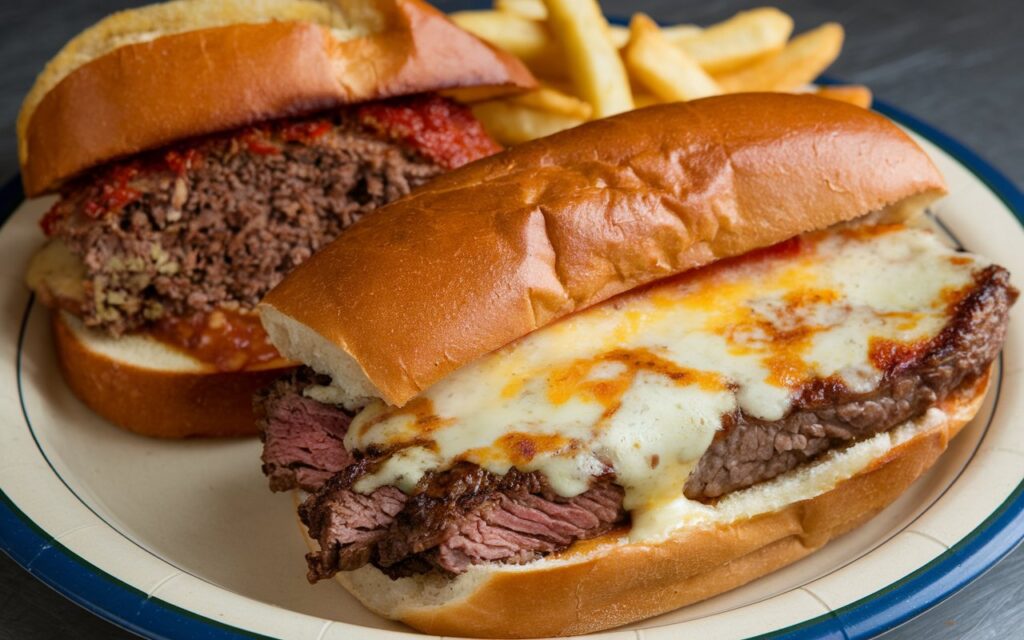
Meatloaf, on the other hand, embodies family traditions and nostalgia. It often takes center stage at Sunday dinners or holiday gatherings, evoking memories of home-cooked meals.
Its appeal lies in its versatility and simplicity. Recipes are often passed down through generations, with each family adding its unique touch. Whether served with mashed potatoes or transformed into meatloaf sandwiches, this dish remains a cornerstone of American comfort food culture.
8. Comparing Cheesesteak and Meatloaf: What Sets Them Apart
While both dishes qualify as comfort food, they cater to different cravings and occasions. Cheesesteak, with its sizzling beef and melted cheese, satisfies a fast-food craving, ideal for on-the-go indulgence. In contrast, meatloaf is rooted in homestyle cooking, offering a slower, more intimate dining experience.
9. How Cheesesteak Became a Fast-Food Icon
The cheesesteak’s portability and quick preparation made it a natural fit for the fast-food industry. Its rise was fueled by roadside diners, food trucks, and chains like Charleys Philly Steaks. Today, it competes with burgers and pizza as one of America’s top fast-food choices.
10. The Homestyle Appeal of Meatloaf in Family Kitchens
Unlike cheesesteak, meatloaf thrives in the family kitchen. Its preparation allows for creativity, from experimenting with spice blends to incorporating leftover ingredients. Served fresh from the oven or as leftovers, meatloaf exemplifies the phrase made with love.
Part 2: Ingredients and Preparation
11. Key Ingredients for the Perfect Cheesesteak
The secret to an unforgettable cheesesteak lies in its simplicity. High-quality ingredients, prepared correctly, make all the difference. Here’s what you need for the perfect bite:
- Bread: A soft, slightly chewy roll that holds up to juicy fillings without falling apart.
- Meat: Thinly sliced ribeye steak, prized for its tenderness and marbling.
- Cheese: Provolone, American, or the classic Cheese Whiz.
- Toppings: Fried onions, peppers, mushrooms, or a dash of hot sauce for added flair.
Each ingredient plays a critical role in balancing texture and flavor, creating a sandwich that’s as satisfying as it is indulgent.
12. Bread Selection: The Foundation of a Great Cheesesteak
The bread is arguably the most underrated component of a cheesesteak. Authentic versions call for Amoroso rolls, which are:
- Soft enough to complement the tender meat.
- Sturdy enough to absorb juices without becoming soggy.
Substitutes like hoagie rolls or baguettes can work, but they may lack the iconic Philadelphia texture. A light toasting can add extra crunch, elevating the overall experience.
13. Choosing the Best Cheese: Provolone vs. Cheese Whiz
When it comes to cheese, preferences run deep:
- Provolone: Offers a sharp, tangy flavor that appeals to traditionalists.
- Cheese Whiz: Delivers a creamy, melty consistency that has become synonymous with cheesesteaks.
- American cheese: A balanced option, offering mild flavor and excellent meltability.
Each cheese option brings its own unique character, so experimenting with combinations is encouraged.
14. The Ideal Meat Cuts for Cheesesteak: Ribeye and Beyond
Ribeye steak is the gold standard for cheesesteaks due to its:
- Tenderness: Ribeye slices cook quickly and remain juicy.
- Flavor: The marbling enhances richness and ensures a succulent texture.
For budget-friendly options, sirloin or flank steak can be used, but they may require additional tenderizing. Proper slicing is key: thin cuts ensure even cooking and seamless layering.
15. Essential Ingredients for a Flavorful Meatloaf
Creating a moist, flavorful meatloaf requires more than just ground meat. Essential ingredients include:
- Ground meat: A blend of beef, pork, or turkey provides depth and balance.
- Binders: Eggs and breadcrumbs ensure the loaf holds its shape.
- Moisture enhancers: Milk, ketchup, or even grated vegetables prevent dryness.
The goal is to strike a balance between structure and flavor, ensuring every bite is both tender and satisfying.
16. Adding Texture: Breadcrumbs, Oats, and Other Binders
Binders are the unsung heroes of a well-made meatloaf. They add structure while preventing a dense, heavy texture. Common options include:
- Breadcrumbs: Classic and reliable, offering a fine texture.
- Oats: A heartier option, adding a rustic touch.
- Crushed crackers: Impart subtle flavors, depending on the variety used.
Choosing the right binder depends on personal preference and desired consistency.
17. Meatloaf Seasoning and Spice Blends: How to Enhance Flavor
The seasoning is where meatloaf can truly shine. A basic blend includes salt, pepper, garlic powder, and onion powder. For added depth:
- Incorporate herbs like parsley, thyme, or rosemary.
- Use smoked paprika or chili flakes for a subtle kick.
- Experiment with global flavors like cumin or soy sauce for a fusion twist.
The key is to layer flavors without overwhelming the dish’s comforting essence.
18. Cheesesteak Cooking Techniques: Griddling vs. Frying
Griddling is the preferred cooking method for a traditional cheesesteak, offering:
- Even cooking: The flat surface ensures uniform heat distribution.
- Flavor retention: The meat cooks in its juices, enhancing richness.
Alternatively, frying in a skillet or cast iron pan can yield a slightly crispier texture, ideal for those who enjoy a caramelized finish. Regardless of the method, high heat is essential to lock in the meat’s juiciness.
19. Baking the Perfect Meatloaf: Temperature, Timing, and Glazing
The secret to a perfect meatloaf lies in careful baking. Key tips include:
- Temperature: Bake at 350°F (175°C) for even cooking.
- Timing: A standard loaf requires 45–60 minutes, depending on size.
- Glazing: Apply a ketchup-based glaze during the last 15 minutes for a tangy, caramelized finish.
Using a meat thermometer ensures accuracy—an internal temperature of 160°F (71°C) is ideal for safety and succulence.
20. Common Mistakes to Avoid When Making Cheesesteak or Meatloaf
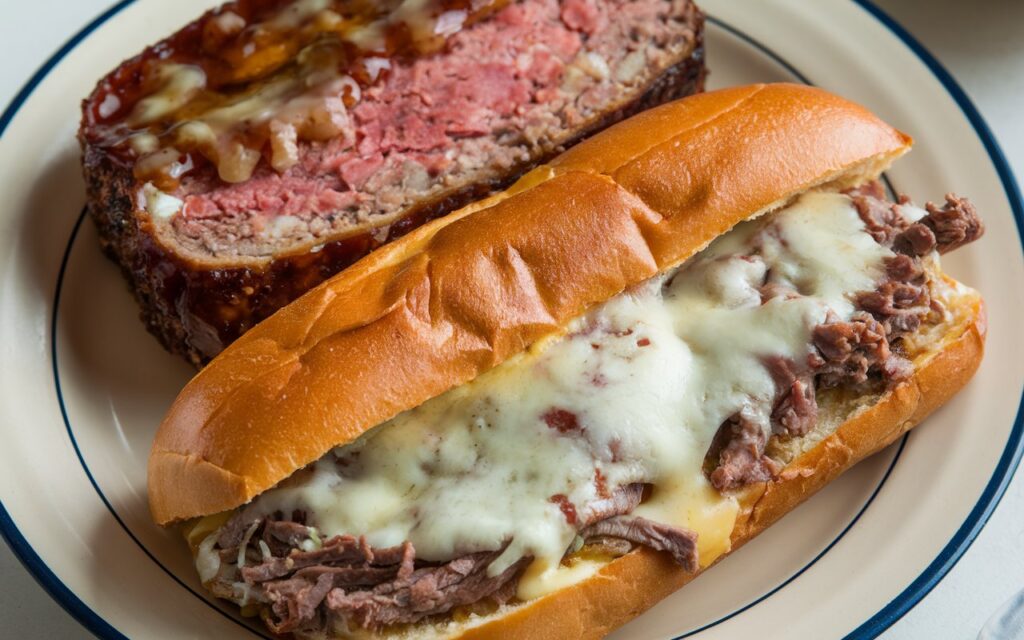
Mistakes can undermine even the best intentions. Avoid these pitfalls:
- Cheesesteak:
- Overloading the sandwich, causing structural issues.
- Using low-quality or overly lean cuts of meat.
- Neglecting the bread’s role in absorbing flavors.
- Meatloaf:
- Overmixing the ingredients, leading to a dense texture.
- Skipping binders, causing the loaf to crumble.
- Under-seasoning, resulting in a bland dish.
Attention to detail ensures both dishes deliver their signature comfort and satisfaction.
Part 3: Variations, Pairings, and Trends
21. Cheesesteak Variations: Chicken, Veggie, and Vegan Options
The classic cheesesteak may be a beef-lover’s dream, but its versatility has inspired many delicious variations. These include:
- Chicken cheesesteak: Thinly sliced chicken replaces beef, offering a leaner alternative without compromising on flavor.
- Vegetarian options: Portobello mushrooms or jackfruit mimic the texture of meat, while hearty vegetables like bell peppers and zucchini create a satisfying filling.
- Vegan cheesesteak: Plant-based proteins such as seitan or tofu, combined with dairy-free cheese, make this version accessible to a wider audience.
These adaptations demonstrate the dish’s ability to evolve while retaining its comfort food status.
22. Gourmet Cheesesteak Trends: Upscale Twists on a Classic
In recent years, cheesesteak has entered the world of gourmet dining. Upscale restaurants are reimagining the sandwich with premium ingredients like:
- Wagyu beef: Elevates the dish with unparalleled tenderness and flavor.
- Artisan cheeses: Gruyère or smoked gouda add a sophisticated touch.
- Truffle oil: Infuses the sandwich with a luxurious aroma and depth.
These high-end variations cater to foodies seeking a unique twist on this beloved classic.
23. Creative Meatloaf Recipes: Bacon-Wrapped, Turkey, and Beyond
Meatloaf’s versatility allows for endless creativity in the kitchen. Popular innovations include:
- Bacon-wrapped meatloaf: Smoky, crispy bacon encases the loaf, enhancing both flavor and texture.
- Turkey meatloaf: A lighter alternative with the same comforting appeal.
- Stuffed meatloaf: Cheese, vegetables, or even hard-boiled eggs are incorporated for surprise flavors in every slice.
These variations breathe new life into a dish often associated with tradition.
24. Fusion Dishes: Cheesesteak Egg Rolls and Meatloaf Burgers
Chefs are combining cheesesteak and meatloaf with other culinary staples to create innovative fusion dishes:
- Cheesesteak egg rolls: Crispy wrappers filled with seasoned beef, melted cheese, and sautéed onions provide a portable twist.
- Meatloaf burgers: Patties made from classic meatloaf ingredients are grilled and served on buns for a unique burger experience.
These hybrids appeal to adventurous eaters and showcase the adaptability of these comfort foods.
25. Best Side Dishes for Cheesesteak: Fries, Onion Rings, and More
Pairing the right sides can enhance your cheesesteak experience. Popular options include:
- French fries: The classic accompaniment, often loaded with cheese or chili.
- Onion rings: Crispy, golden, and perfect for dipping.
- Coleslaw: Adds a refreshing crunch and balances the sandwich’s richness.
Each pairing complements the cheesesteak’s bold flavors, making it a complete meal.
26. Meatloaf Accompaniments: Mashed Potatoes, Gravy, and Beyond
Meatloaf shines brightest when paired with hearty sides. Traditional accompaniments include:
- Mashed potatoes: Creamy, buttery, and the ultimate comfort food pairing.
- Gravy: Adds moisture and flavor, elevating every bite.
- Green beans or roasted vegetables: Bring color and nutrition to the plate.
These sides round out the dish, creating a satisfying and balanced meal.
27. Healthy Cheesesteak and Meatloaf Alternatives
For those seeking lighter options, both dishes can be adapted to meet dietary needs:
- Cheesesteak:
- Use whole-grain rolls and lean cuts of meat.
- Incorporate veggies like spinach or arugula for added nutrients.
- Opt for low-fat or dairy-free cheese.
- Meatloaf:
- Replace ground beef with turkey or plant-based alternatives.
- Swap breadcrumbs for almond flour or rolled oats.
- Reduce sodium by using fresh herbs instead of processed seasonings.
These tweaks retain the dishes’ essence while promoting health-conscious eating.
28. Cheesesteak and Meatloaf in Food Trucks: Street Food Culture
The rise of food trucks has introduced cheesesteak and meatloaf to a new audience, blending convenience with creativity. Popular offerings include:
- Cheesesteak sliders: Bite-sized versions perfect for snacking on the go.
- Mini meatloaf cups: Individual portions served with a dollop of mashed potatoes or gravy.
Food trucks often experiment with bold flavors and unconventional pairings, making these comfort foods exciting and accessible.
29. Home-Cooking vs. Dining Out: Where to Find the Best Versions
Choosing between homemade and restaurant versions of these dishes depends on the experience you’re seeking:
- Home-cooked:
- Offers customization and a personal touch.
- Allows for healthier ingredients and portion control.
- Creates a sense of nostalgia and family bonding.
- Dining out:
- Provides authentic versions, especially in regions like Philadelphia for cheesesteak.
- Offers unique twists or upscale presentations in gourmet settings.
- Delivers convenience for those craving instant satisfaction.
Both options celebrate the versatility and universal appeal of these dishes.
30. The Future of Cheesesteak and Meatloaf: Sustainability and Innovation
As the food industry evolves, so do these iconic dishes. Emerging trends include:
- Sustainable sourcing: Using ethically raised meats and local produce to reduce environmental impact.
- Plant-based innovations: Beyond Meat and similar products offer eco-friendly alternatives that mimic traditional flavors.
- Creative presentations: Chefs continue to push boundaries with deconstructed or fusion-style adaptations.
The future of cheesesteak and meatloaf lies in their ability to adapt while staying true to their comfort food roots.
More FAQs
- What makes a cheesesteak authentic?
- Thinly sliced ribeye, Amoroso rolls, and Cheese Whiz or provolone.
- Can I make a vegan cheesesteak at home?
- Yes! Use seitan or jackfruit and pair with dairy-free cheese.
- What’s the secret to moist meatloaf?
- Add moisture enhancers like milk or grated vegetables.
- Are there gluten-free options for these dishes?
- Yes, use gluten-free bread or rolls and replace breadcrumbs with alternatives like almond flour.
- What’s the best cheese for cheesesteak?
- Provolone for sharpness or Cheese Whiz for creamy authenticity.
- Can meatloaf be frozen?
- Absolutely. Freeze cooked or uncooked loaves for future meals.
- What are common cheesesteak toppings?
- Fried onions, peppers, mushrooms, and hot sauce.
- How can I make meatloaf healthier?
- Use lean meats, add vegetables, and reduce salt.
- What’s the origin of cheesesteak?
- Philadelphia in the 1930s, invented by Pat and Harry Olivieri.
- What’s the most popular side for meatloaf?
- Mashed potatoes topped with gravy.
Would you like help with additional sections or detailed recipes?
